ZIL-135: engineering refinements of Dr. Grachev
Outland Constructor
In previous parts The cycle dealt with search mockups of future missile carriers and the first floating prototypes. The third section is worth starting with the personality of the chief designer of the Special Design Bureau of ZIL and the mastermind of the 135 series machines, doctor of technical sciences, Vitaliy Andreevich Grachev, laureate of two Stalin Prizes.
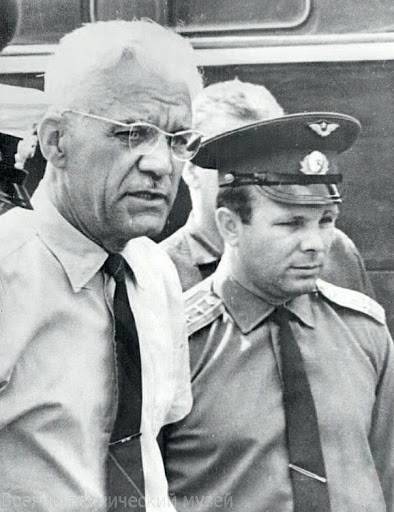
Vitaly Grachev and Yuri Gagarin. Source: gvtm.ru
The designer of the first magnitude, who laid the foundation for the further development of off-road equipment in our country, has not received a higher education. According to legend, for non-proletarian origin he was expelled from the Tomsk Polytechnic School. Until 1931, Vitaly Andreyevich, one might say, was looking for himself, that is, he worked as a loader, a film and radio mechanic, a designer at the Yegorov plant, an aircraft mechanic in the army, and also managed to build a glider. But with aviation the future car designer did not work out. In December 1931, to mobilize the Lensovnarkhoz Grachev, they were sent to the Nizhny Novgorod automobile plant under construction, the future GAZ. The country lacked automobile technology so much that during the construction of the plant the first T-27 wedges assembled there were used as tractors. The young engineer was immediately identified for the development of off-road vehicles in the development team of the NAZ-NATI-30 machine. Grachev supplemented the technique of a three-axle truck with a demultiplier, a rear balancer suspension, rocket rods, a hitch device, and the car went under the name GAZ-AAA in a series.
In the design career of Vitaly Andreevich, there was also disgrace: in 1933 he was transferred to the post of assembly master in one of the branches of the car factory. In many respects, this was a consequence of Grachev's intransigence on fundamental issues of car design. He was not afraid to criticize the seemingly incorrect layout errors. Grachev did not stay in the post of master for long and already by 1936 had built a three-axle pickup truck GAZ-AAAA according to the 6x4 scheme.
The designer not only knew how to handle the culman well in the design bureau, but also liked to "go out into the field." So, on his pickup truck, he personally went to the most difficult test run in Karakum - in total, the designer traveled 12 kilometers in his car. After there was an almost serial GAZ-291 model of 21 (not to be confused with the legendary Volga GAZ-1936). Such cargo-passenger “triaxles” were collected about a hundred copies.
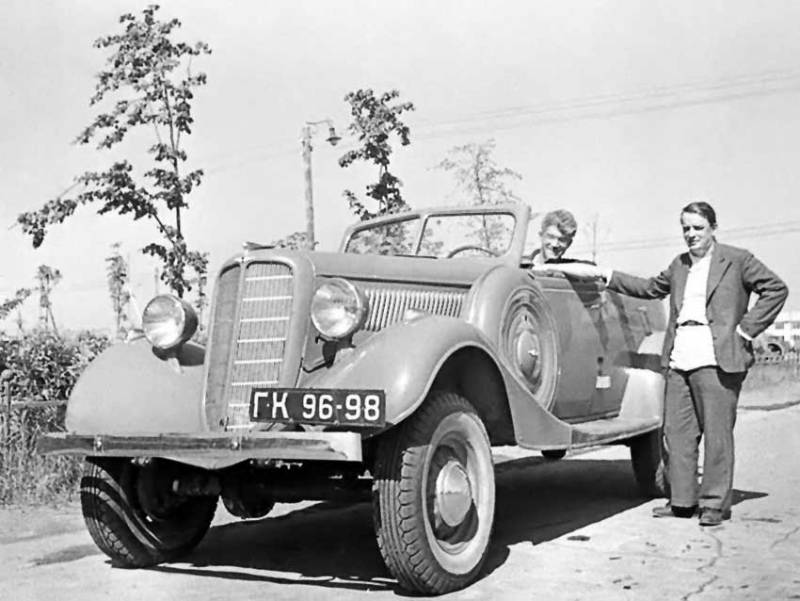
Leading designer V. A. Grachev and chief designer of GAZ A. A. Lipgrad (right) near the first GAZ-61-40 all-wheel drive car. Source: rim3.ru
But it is one thing to develop off-road vehicles in which this cross-country ability was provided by a simple docking of an additional axis at the rear, and another to create a machine with a front driven drive axle. This was a very non-trivial task for the Soviet Union in the mid-30s. Vitaly Grachev dealt with her.
The main problem was the design of the constant-velocity hinge of the Weiss type, for which the country did not have a license. The first-born was the GAZ-61-40, a two-axle passenger all-wheel drive car, after the development of which Grachev gained real fame. The car got into small-scale production, in particular, the GAZ-61-73 sedan collected only 194 copies. Most of the series was used as VIP cars for senior command personnel: K. Voroshilov, S. Timoshenko, G. Zhukov, K. Rokossovsky, I. Konev, S. Budyonny and others.
In early 1941, People's Commissar Malyshev actually ordered Grachev to create a domestic analogue of the American Bantam: the army urgently needed an inexpensive and simple all-terrain vehicle. So there is the GAZ-64, which in many respects surpasses its prototype, and in January 1942, on its basis, the designer builds a light machine gun BA-64 armored car. Grachev receives his first Stalin Prize for this development of defense.
In the design biography of the protagonist in 1944, the Dnepropetrovsk Automobile Plant and work on the triaxial amphibian DAZ-485 appeared. The machine was created under the influence of the Lendliz floating GMC DUKW-353, and one of the most important achievements of the design team was the development of a centralized pumping system for wheels. After that, swapping became the trademark of the entire line of automotive equipment of the Soviet Army. For amphibious DAZ-438 Grachev in 1951 received his second Stalin Prize. In the same year, the designer was transferred to Moscow to the ZIS, where a special design bureau for the development of military equipment of the "medium" format was created at the initiative of Georgy Zhukov. The head of the design bureau is Vitaly Grachev. The main profile of the bureau's work is artillery tractors and missile carriers. At this place, the designer worked until his death in 1978.
In addition to numerous books and memoirs, the film “The Beyond Designer” from the series “Secrets of Forgotten Victories” was shot about the famous Grachev. In particular, in this film, the name of Vitaly Grachev is placed on a par with such automotive designers as Henry Ford, Henry Leland (founder of Cadillac) and Ferdinand Porsche.
For ZIL, the presence of SKB during its entire existence was frankly burdensome. In fact, Grachev’s office was protected only by the patronage of the military and the space industry. At the same time, engineers and designers of SKB had the right to attract the forces of the main plant to fulfill particularly important orders. The management of the plant often responded to this with the involvement of engineers and special bureaucrats at ZIL jobs. Grachev, of course, how could he resisted this, which caused antipathy with the management of the enterprise. In many ways, the whole situation was the result of a chronic shortage of workers at the main plant. According to Vladimir Piskunov, one of the engineers at SKB, and subsequently the deputy chief designer of ZIL refrigerators, hard work, strict discipline of the security company and low earnings compared to similar work at defense enterprises forced people to leave the factory. I had to replace vacant jobs with workers from all over the Soviet Union who worked successfully, got Moscow apartments and ... left the factory. And so over and over again over the years. When orders from the military for the Special Design Bureau seriously decreased, the ZIL Directorate began to demand every month one of the bureau workers on the main conveyor. This happened after the death of Grachev in the early 80's. It got to the point that the acting chief designer Vladimir Shestopalov, not finding volunteers for the next “corvée” in the Design Bureau, went to work himself as a collector on a conveyor.
But these were the sunset years of Grachev SKB, and in the golden era of the domestic automotive industry, such a unique thing as the ZIL-135 appeared.
The brainchild of the Grachev firm
Most of the off-road vehicles developed at SKB were distinguished by special engineering refinements, many of which found their place in ZIL-135. First of all, these are tires of the maximum possible size for the layout, thin-layer, with developed lugs, as well as high ground clearance with a flat bottom of the machine and a front inclined “entry” sheet. All this required the use of off-center or twin-shaft wheel gearboxes, which made it possible to simplify the air supply to the tires and brake fluid to the sealed brake mechanisms. On 8x8 machines, which include ZIL-135, a differential drive is used with a separate wheel drive for the wheels of each side. Grachev was led by unsuccessful tests of early prototype units on prototypes No. 1 and No. 2 ZIS-E134, ZIL-134 and ZIL-157R to go on reducing the number of differentials to zero. On these machines, worm-screw differentials of the Walter type were mounted with adjustable friction clutches of the Thornton Power-Lock type and freewheels of the Nou-Spin type. All of them were rejected at various stages of testing the equipment.
The next characteristic “signature” of the SKB technique was the symmetrical wheel layout 1 - 2 - 1 for 8x8 cars. Swivel made front and rear wheels. In addition to the fact that this unconventional technique increased maneuverability and maneuverability (the wheels moved along one track), it allowed the wheels to be turned only 15-17 degrees. And this is the possibility of placing large wheels, and greater reliability of the joints of equal angular speeds. A distinctive feature of SKB machines has been the widespread use of filled fiberglass in the manufacture of cabins, gas tanks, amphibian bodies, wheel rims, torsion bars and honeycomb frames. For floating machines, units under water were invented to pressurize air under pressure through an aircraft pressure reducing valve. Grachev was very skeptical about winches using his own technique. The argument was simple - the cross-country ability was so high that there was no need for it. And if suddenly any all-terrain vehicle gets bogged down, then no winch will save. This principle follows, perhaps, from the main credo of the whole Grachev Design Bureau - the fight against overweight equipment by any available means. Even if for this you have to raise the cost of the structure with aluminum, magnesium or titanium. The chief designer demanded not to put an excessive margin of safety in the equipment - everything should work to the maximum without unnecessary weight. “The stock is pulling,” Grachev said about this. It is difficult to judge how justified this was, but the SKB technique cannot be called unsurpassed in terms of reliability.
The first car of the 135th series with the usual characteristic appearance of the cabin was the ZIL-135E model of 1960. The car was deprived of the suspension, which did not particularly concern the rocket launchers, for whom the all-terrain vehicle was intended. The fact is that they did not expect to drive a lot on paved roads, but the lateral stability of the car increased - this was important when loading missiles. The wheels were connected to the frame through a hard bracket made of magnesium alloy - evaluate the degree of technical elegance of Vitaly Grachev's design school. Naturally, these brackets were mercilessly broken during tests and on steered wheels they had to be cast from grade 30 steel. Also, in comparison with prototypes in SKB, the spacing of the base of the extreme wheels was increased. This made it possible to place on the ZIL-135E launcher 2P21 tactical missile system "Luna" with an inclined launch. Also, under the requirements of the rocket launchers, the gas tanks were moved forward and the middle and rear parts of the frame were freed to improve the gas exhaust of the starting winged product. The plastic of the cab, which was mentioned above, appeared on the car not because of the fight against weight, but to counter the gas rocket jet. The steel cabin was irreversibly deformed, but the polyester resin filled with fiberglass returned after launch weapons to the original form. The cabin did not have a metal frame and consisted of eleven large plastic parts fastened together with an epoxy. Such are the high military technologies. In addition to the cab, gas tanks and the plumage of the machine were made of plastic.
By the spring of 1961, two manufactured machines had passed the entire cycle of necessary tests and, it would seem, were ready to go into series. Passability ZIL-135E was impressive. The machine confidently took 27-degree climbs, overcame meter-deep swamps, and an eight-wheeled rocket carrier walked along beaten country roads with speeds significantly exceeding those of spring-loaded counterparts. But everything spoiled the lack of suspension. Since there is no suspension, there are no shock absorbers that dampen vibrations. At speeds of 22-28 km / h, the first wave of dangerous resonant vibrations came, the second came when reaching 50 km / h. And if the car “successfully” fell on a special profile of the road, then the vibrations passed into sensitive shocks, requiring seat belts for three crew members. "Galloping" loaded with a ZIL-135E rocket on undulating asphalt began already at 40 km / h with a frequency of 120 units per minute. It was possible to stop such dangerous habits of a 16-ton missile carrier by sharp braking with a speed reduction of 30-50%, as well as a decrease in tire pressure to one atmosphere. In addition, the military did not like the low reliability of individual components of the machine (hello to the principles of Grachev's design) and excessive fuel consumption in the region of 134 l / 100 km. Each column of such missile carriers required the same column of fuel trucks.
As a result, it was decided to abandon the ZIL-135E prototypes in order to develop a modified ZIL-1961L by the spring of 135, which became a truly massive development of the Grachev company.
To be continued ...
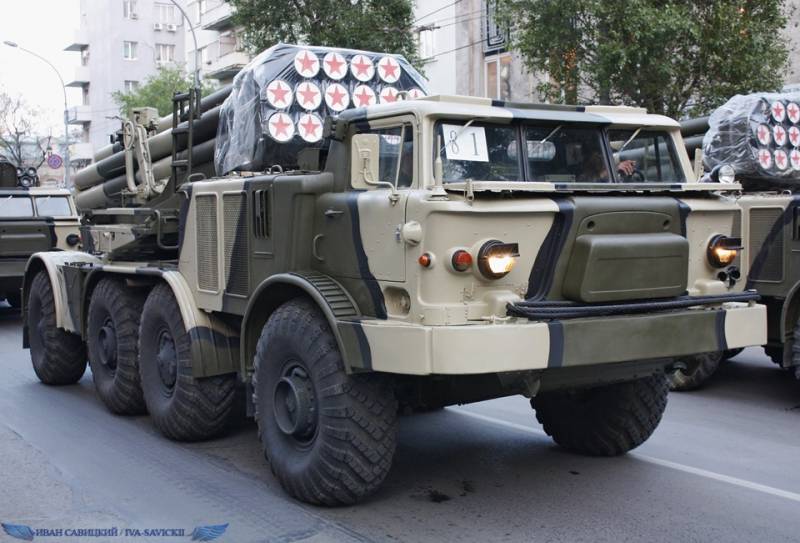
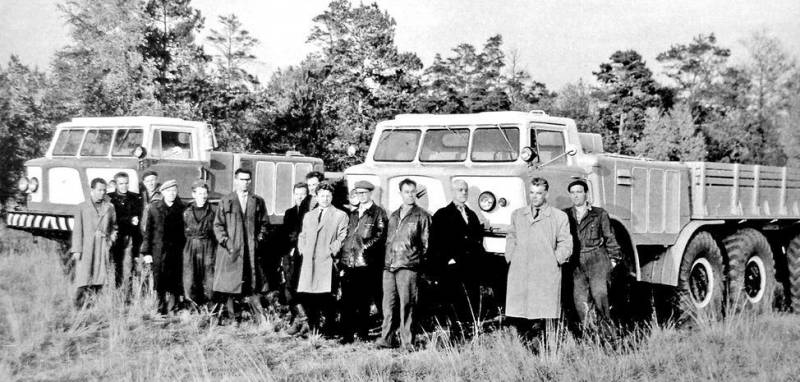
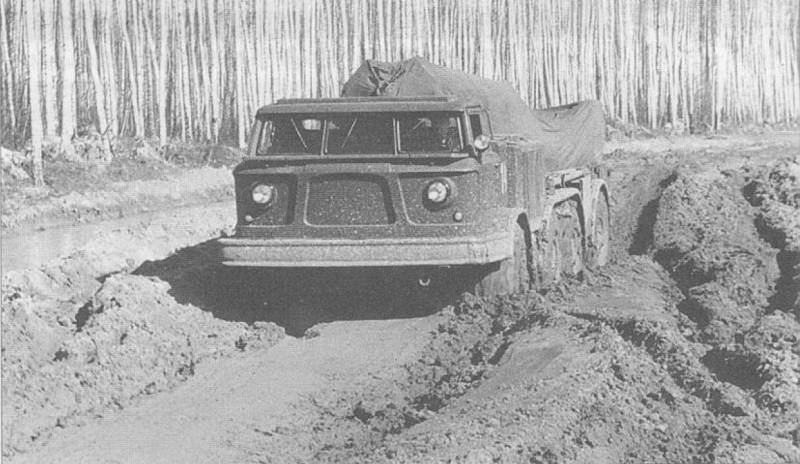
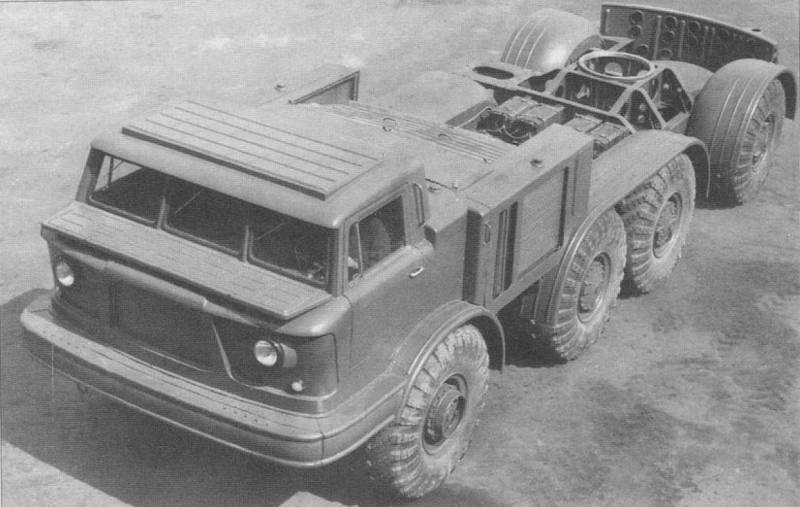
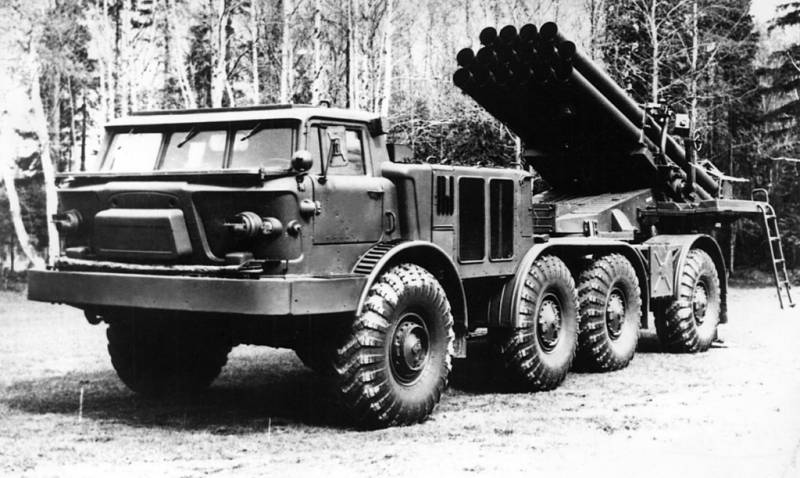
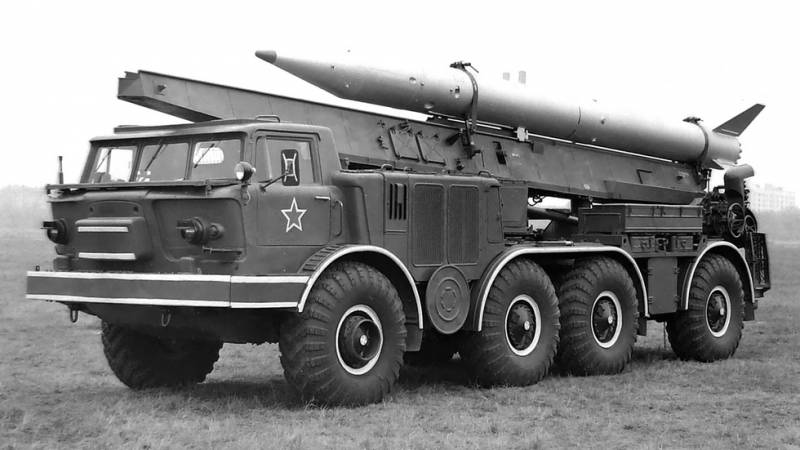
Information